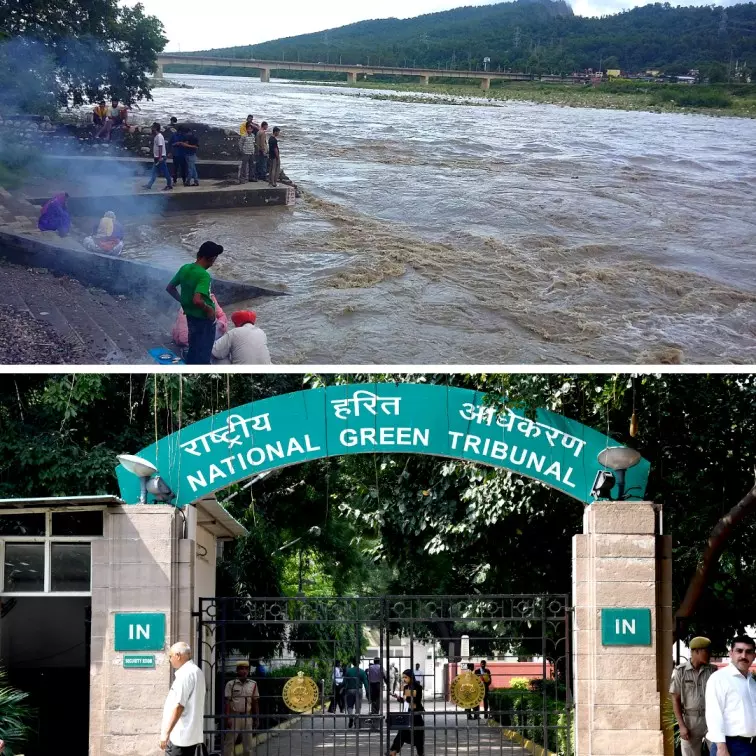
Image Credit: Wikimedia, Tribune India
NGT Creates A High-Level Committee To Tackle Pollution In Yamuna River
Writer: Deepthi Rao
She is a postgraduate student pursuing Multimedia Journalism at Christ Deemed to be University. She believes in the power of storytelling and truth. "Do it with passion or not at all."
India, 13 Jan 2023 11:41 AM GMT
Editor : Jayali Wavhal |
She writes about gender issues, human interest, and environment.
Creatives : Jayali Wavhal
She writes about gender issues, human interest, and environment.
The National Green Tribunal was hearing a petition over the Yamuna River's pollution, which claimed that despite specific directives from the Supreme Court and the NGT, the relevant agencies had consistently failed to take necessary corrective action.
The National Green Tribunal (NGT), on Monday (January 9), set up a high-level committee to address the Yamuna river pollution problem. The NGT was hearing a petition over the Yamuna River's pollution, which claimed that despite specific directives from the Supreme Court and the NGT, the relevant agencies had consistently failed to take necessary corrective action.
No Corrective Action Taken Despite Previous Orders
According to a bench led by Justice A K Goel, the Yamuna's rejuvenation plan's defined steps have not been completed in full, and there is still a significant gap between the amount of sewage produced and the facilities that can handle it. The court ruled that the past orders of the tribunal regarding the contamination of the Yamuna River had not been followed.
The bench, as per a report by the Business Standard, said, "The estimated gap is said to be 194.5 million gallons per day (MGD) of sewage, interception and diversion of about 147 drains (connected to Najafgarh and Shahdra drains) and other small drains joining bigger drains remains (pending) and wastewater from 1,799 unauthorized colonies and 630 JJ clusters is reportedly going into the Yamuna."
According to the bench, other unfinished projects include the DDA's riverfront revitalization initiatives and the desilting or desludging of drains. The data from the Delhi Pollution Control Committee (DPCC) were cited, which revealed that the Yamuna River's water quality displayed "high levels of biological oxygen demand (BOD)" and "innumerable amounts of faecal coliform."
The court further blamed the Delhi government stating that multiple authorities in Delhi have prevented it from taking necessary measures. The tribunal claimed that the DPCC failed to take coercive action against negligent businesses or local governments that "rampantly" kept dumping rubbish into the Yamuna River and sewers.
The green panel recommended that in addition to implementing engineering, structural, and biological steps for a thorough catchment area treatment plan, trees be planted on the river's flood plains and in the drains' buffer zones. "There is also a need to consider utilisation of treated sewage water for agriculture or other purposes, discouraging the use of chemical fertilizer and insecticides, to the extent viable and for maintaining and restoring the ecological integrity of river Yamuna, eco-technology may be used," it stated.
Formation Of High-Level Committee
The court established a high-level Committee (HLC) of authorities in Delhi, where Yamuna pollution is higher (by roughly 75 per cent) than in other river basin states, to address concerns about the growing pollution issue.
The chairman of the Central Pollution Control Board, the director general of the National Mission for Clean Ganga, the chief secretary, secretaries of various Delhi government departments, the CEO of the Delhi Jal Board, officials from the DDA, and the Union Ministries of Agriculture, Jal Shakti, and Environment would also serve on the committee (NMCG).
The committee must physically convene within a week to assess the situation in relation to the tribunal's directives, the degree of compliance, planned corrective action, sources of finance, responsibility for prior failures, and project execution methodology and timetables, according to the tribunal.
"The committee may explore provision for separate channels for carriage of sewage instead of mixing the same with stormwater. The committee may ensure that de-sludged or dredged material is disposed of as per norms at the earliest, preventing re-entry in the river and damage to the flood plains", the bench said.
The tribunal stated that the committee's goals should be quantifiable and clear because the performance of the committee would be judged by how much pollution is reduced as a result.
According to the tribunal, the committee had until January 31 to present its initial report.
Also Read: Union Cabinet Approves Rs 19,744 Cr For National Green Hydrogen Mission, All You Need To Know
 All section
All section













